40th Oi Match Game 1
Black: Tanigawa Koji, Challenger
White: Habu Yoshiharu, Oi
40th Oi-sen, Game 1, July 13th and 14th 1999
1.P7g-7f 1/1 0/0
Habu comes into this game without a win in an official tournament game in more
than three months, while Tanigawa is in great form with a five game winning
streak, including a three game sweep of the Kisei match. Before the game,
Tanigawa was considered to be the favourite in this match.
2.P3c-3d 0/1 2/2
3.P2g-2f 3/4 0/2
4.P8c-8d 0/4 2/4
5.P2f-2e 1/5 0/4
6.P8d-8e 0/5 1/5
7.G6i-7h 0/5 0/5
8.G4a-3b 0/5 3/8
9.P2e-2d 2/7 0/8
10.P2cx2d 0/7 1/9
11.R2hx2d 0/7 0/9
12.P8e-8f 0/7 3/12
13.P8gx8f 0/7 0/12
14.R8bx8f 0/7 0/12
15.R2dx3d 20/27 0/12
16.B2b-3c 0/27 12/24
17.R3d-3f 34/61 0/24
18.S3a-2b 0/61 18/42
19.P*8g 25/86 0/42
20.R8f-8e 0/86 1/43
There it is again. The R8e variation of the Yokofudori. Habu shows that he
is still confident he can win with this opening against Tanigawa, despite
losing both of the previous games they played with it (one time with black
and one time with white).
21.R3f-2f 0/86 0/43
22.K5a-4a 0/86 21/64
23.K5i-6h 21/107 0/64
24.S7a-6b 0/107 25/89
25.S3i-3h 6/113 0/89
26.G6a-5a 0/113 11/100
27.P3g-3f 7/120 0/100
The K6h-P3f shape is a relatively new idea against the R8e variation.
28.P7c-7d 0/120 21/121
29.N2i-3g 13/133 0/121
30.N8a-7c 0/133 22/143
31.P4g-4f 69/202 0/143
32.P5c-5d 0/202 59/202
33.B8hx3c+ 56/258 0/202
The sealed move at the end of the first day of play.In a new variation like
the R8e Yokofudori there are a lot of possibilities that can be explored
and this explains why the pace of this game is quite slow.
34.N2ax3c 0/258 2/204
35.S7i-8h 2/260 0/204
36.P5d-5e 0/260 23/227
37.P6g-6f 20/280 0/227
Stops N6e.
38.P5e-5f!? 0/280 28/255
A good counter, but...
39.P5gx5f 0/280 0/255
40.P7d-7e?! 0/280 0/255
This is not the best move. Tanigawa expected P*5e Px5e P*5f G6g Rx5e which
is better. "I should have thought a little longer about P*5e" (Habu).
41.P*2c! 45/325 0/255
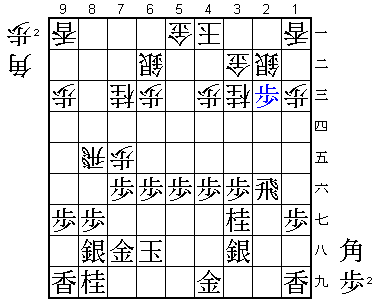
Strong move that seems to give black the advantage.
42.S2bx2c 0/325 85/340
43.P*2d 0/325 0/340
44.S2c-1b 0/325 0/340
Not good is 42.S3d B*2c and black wins.
45.P3f-3e 2/327 0/340
46.P*3f 0/327 1/341
47.R2fx3f 23/350 0/341
48.B*1d 0/350 7/348
49.R3f-2f 2/352 0/348
50.R8e-8d 0/352 0/348
A little painful to have to retreat this rook, but after immediately P*3f P3d,
the white king on 4a is too close to the black attack.
51.P1g-1f 34/386 0/348
Threatens to win the bishop. In the press room the general idea was that black
had the better position. This turns out to be a little optimistic.
52.P*3f 0/386 11/359
53.N3g-4e 1/387 0/359
54.N3cx4e 0/387 0/359
55.P4fx4e 23/410 0/359
This move was criticised by the visiting professionals. However, Tanigawa felt
that after 55.P1e Px3g+ Px1d +Px3h Gx3h S*5g K7i N*5d the white attack is
more dangerous than expected. Indeed, after Px4e Nx6f G6g N5h+ black's wall
silver on 8h makes it very hard to defend. In the post mortem both players
also looked at 55.P1e Px3g+ Px1d +Px3h Px4e +Px4i Px1c+ N6e Px6e S*6f P2c+
but it is hard to say who will win this mating race.
The position turns out to be very deceiving. Black seems to have the upper
hand, but it is impossible to find a variation to get a clear advantage.
Tanigawa is trying so hard to find things that are probably not there, that
he gets into time trouble.
56.P3f-3g+ 0/410 23/382
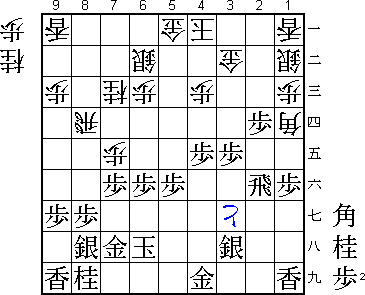
57.P1f-1e? 10/420 0/382
Too preoccupied with the bishop. Black should have played 57.Sx3g B4g+ S4h
P*2e Sx4g Px2f B*5e P2g+ Bx1a+ +P3g S5h and even though white has the strong
N*4f, black has good chances for counter attack with L*5e. "After playing Px4e
I should have chosen this variation" (Tanigawa). He himself thought after the
game that 57.P1e was the losing move.
58.B1d-4g+ 0/420 8/390
59.S3hx4g 2/422 0/390
60.+P3gx4g 0/422 0/390
61.B*5e 0/422 0/390
62.N*6d 0/422 20/410
63.P4e-4d 5/427 0/410
64.N6dx7f 0/427 24/434
65.K6h-7g 0/427 0/434
66.P4cx4d 0/427 1/435
67.P*4b 3/430 0/435
68.G5ax4b 0/430 1/436
69.B*9e 14/444 0/436
70.R8d-7d 0/444 2/438
71.N*5d! 2/446 0/438
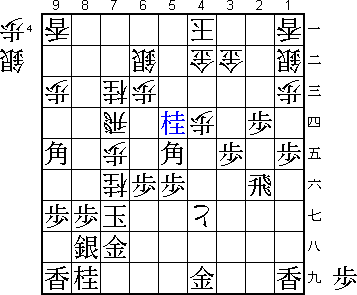
This move shows that the game is far from over. Habu thought he was winning,
but after this move he was no longer sure. Meijin Sato agreed: "I have no
idea who is winning".
72.S*6h! 0/446 24/462
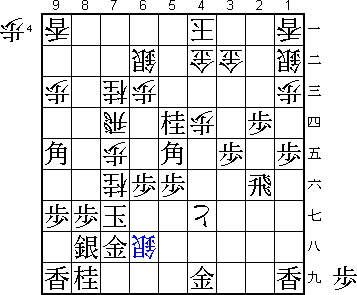
After 72.Rx5d B5ex7c+ Sx7c Bx7c+ the threat +Bx6c is very nasty. 72.S*6h is
a very good move, putting a lot pressure on black. From now on, he has to
play his attack very carefully or he will be mated with the pieces he gives
white. It seems that this moves is just enough for white to win.
73.G7hx6h 5/451 0/462
74.N7fx6h+ 0/451 0/462
75.P2d-2c+ 7/458 0/462
76.S1bx2c 0/458 0/462
77.N5dx4b+ 0/458 0/462
78.K4ax4b 0/458 0/462
79.K7gx6h 1/459 0/462
80.N*7f 0/459 3/465
81.K6h-7g 2/461 0/465
82.P9c-9d 0/461 1/466
83.P*4c 4/465 0/466
84.K4bx4c 0/465 3/469
85.B5ex7c+ 7/472 0/469
86.S6bx7c 0/472 0/469
87.N*5e 0/472 0/469
88.K4c-5b 0/472 1/470
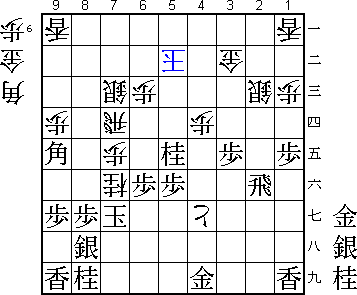
Now it is clear that the white king can escape.
89.S*4c 7/479 0/470
After 89.N*6e Px9e or 89.Bx7c+ B*6h K7h Nx8h+ Kx8h S*7g white wins. In the end,
the game is decided by the fact that the black bishop on 9e is needed in
defence and can therefore not be used to give the attack the final push it
needs.
90.G3bx4c 0/479 2/472
91.N5ex4c+ 0/479 0/472
92.K5b-6a 0/479 0/472
93.+N4c-5b 0/479 0/472
94.K6a-7a 0/479 1/473
Resigns 0/479 0/473
Time: 07:59:00 07:53:00
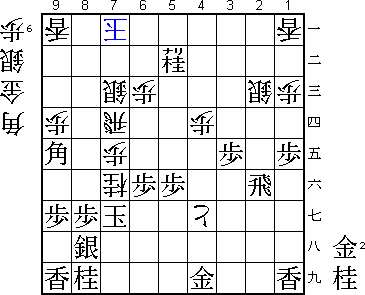
If this first game is an indication of what is too come, we will have a very
close match between these two rivals. Despite being only 94 moves long, this
game was decided by a very small margin. How big will winning with white
be for Habu?





